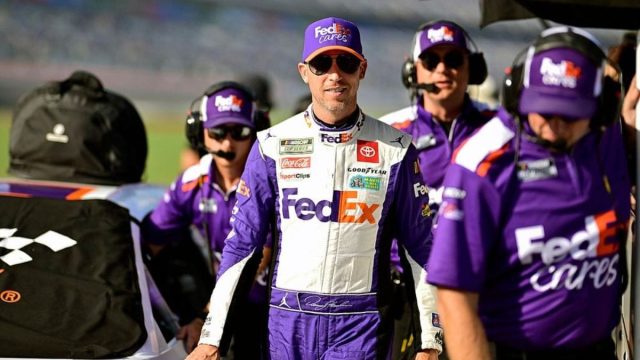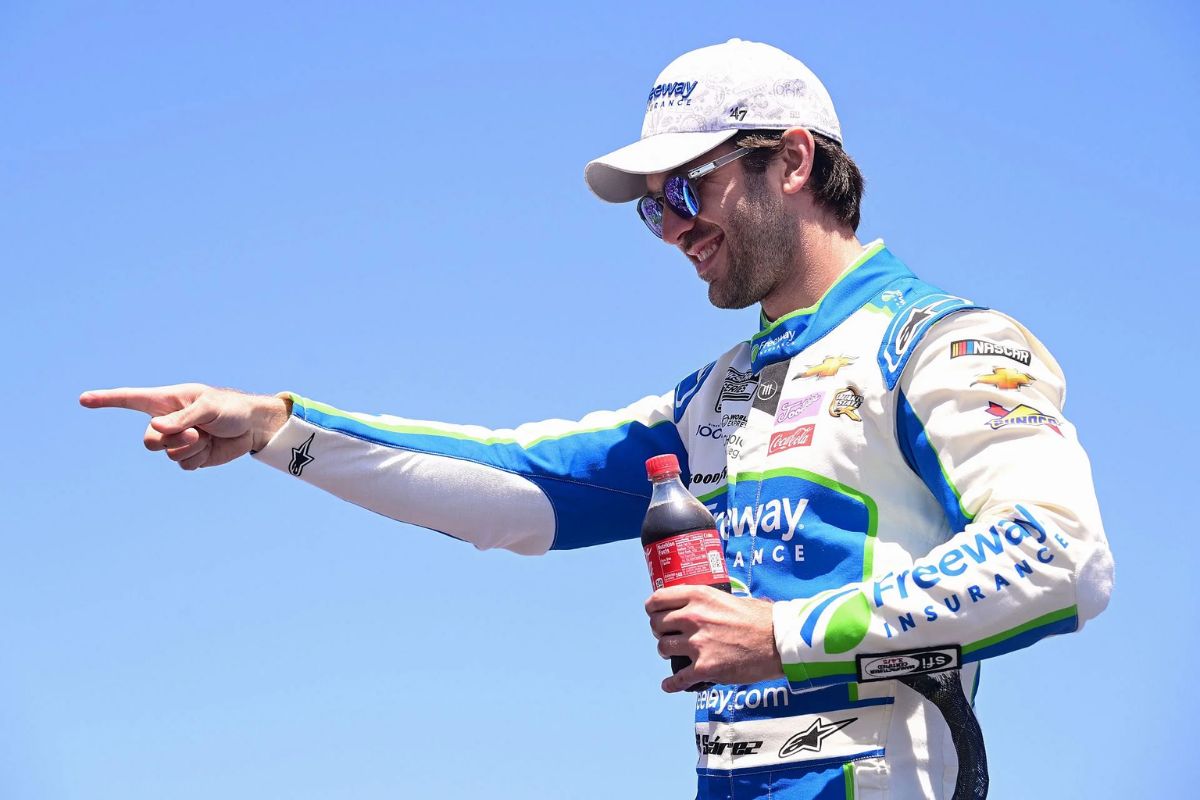Denny Hamlin Accuses Goodyear of Deception: Denny Hamlin‘s recent disclosures regarding Goodyear tires during the Richmond race have sparked notable discourse within the NASCAR community, particularly concerning the implications of quality control issues. By highlighting how older, less effective tires compromised competitive balance and race strategy, Hamlin raises critical questions about the fairness and integrity of tire distribution practices in the sport. As teams grapple with the consequences of inconsistent tire performance, the ethical considerations surrounding NASCAR’s operational standards come into focus. What changes might be necessary to restore confidence in tire reliability and promote a level playing field?
Key Highlights
- Denny Hamlin criticized Goodyear for inconsistent tire quality, affecting competitive fairness across NASCAR teams during the Richmond race.
- Older tires used in the race led to reduced grip and slower lap times, impacting race strategies significantly.
- Hamlin highlighted the tactical disadvantage created by variances in tire age, undermining the integrity of the competition.
- The presence of outdated tires during races raised ethical concerns regarding NASCAR’s tire distribution practices.
Daniel Suarez’s Performance with the ‘Option’ Tire
Daniel Suarez’s remarkable performance at the Richmond Raceway displayed the tactical advantages of the newly introduced ‘option’ tire, which provided enhanced grip and accelerated lap times, ultimately transforming the competitive landscape of the race. This event marked a considerable milestone as it was the primary points race utilizing this tire variant, allowing teams to experiment with strategies that could dictate their overall performance.
The ‘option’ tire, characterized by its softer compound, offers superior traction, enabling drivers to navigate corners with improved stability and speed. During Stage 2 of the race, Suarez capitalized on this advantage, demonstrating an ability to outpace his competitors and maintain a commanding lead. His post-race comments reflect a broader sentiment within the racing community, as he expressed a desire for the ‘option’ tire to be a standard feature across all tracks, emphasizing its potential to enrich the racing experience.
“I don’t see why we don’t have an ‘option’ tire everywhere we go.” – Suarez
Conversely, the ‘prime’ tire, while providing consistent performance, lacks the initial grip that the ‘option’ tire offers. This dichotomy forces teams to weigh the benefits of speed against the sustainability of tire wear throughout a race. The introduction of the ‘option’ tire not only challenges teams to develop creative strategies but also raises the excitement for spectators, as they witness dynamic shifts in race dynamics.
Denny Hamlin’s Claim About Old Tires
Denny Hamlin’s assertion regarding the use of older Goodyear tires at Richmond raises critical questions about the fairness and competitiveness of the race environment. In a race characterized by tactical tire choices, the age and condition of the tires can greatly influence performance outcomes. Hamlin’s claim suggests that some teams may have been disadvantaged by receiving outdated tires, leading to an uneven playing field during the event.
This situation invites scrutiny on several key aspects:
- Performance Impact: Older tires typically exhibit reduced grip and slower speeds, affecting lap times and overall race strategy.
- Tactical Dilemma: Teams are faced with a decision between speed and durability, complicating race tactics and potentially skewing results.
- NASCAR’s Tire Experiment: The introduction of color-coded tires was intended to boost competition; however, the presence of old tires undermines this goal.
As the racing community seeks to guarantee equitable competition, understanding the implications of tire age and performance is crucial for maintaining the integrity of the sport. The Richmond race, with its controversial outcomes, serves as a crucial case study for examining these issues.
Hamlin’s Explanation of the Tire Issue
The recent disclosures from Hamlin regarding the quality control issues with Goodyear tires highlighted the challenges faced by all teams during the race, highlighting the notable effect of tire age on competitive performance.
Hamlin’s insights emphasize a crucial aspect of racing strategy: tire management. He acknowledged that the variances in tire age created an uneven playing field, as some competitors benefited from fresher tires while others grappled with older, slower alternatives.
According to Hamlin, this inconsistency in tire quality was not an isolated issue but rather a universal challenge that affected every team in the field. He stated, “Everyone did. Everyone in the field had some newer tires, some older,” stressing the collective struggle with the equipment provided. This situation raises vital questions regarding the reliability of tire supply and the implications for race outcomes.
The age of a tire greatly influences performance metrics, with older tires inherently resulting in decreased traction and slower lap times. Hamlin pointed out that a driver with a week-old tire would likely outperform another driver using a tire that was a month old.
Example of Tire Impact on Race Performance
An example of how tire performance can dramatically impact race outcomes is found in Hamlin’s observation regarding lap times at Martinsville, where even slight advancements in tire freshness can yield considerable speed improvements. He noted that merely switching to a set of slightly newer tires could result in a three-tenths of a second increase in lap speed, a vital advantage in the highly competitive environment of NASCAR.
“In Martinsville, you would put on a set of tires that was just a little bit newer and your car would go three-tenths faster. You changed nothing. All you did was put on a newer tire and it would go faster.” – Hamlin
The significance of tire performance extends beyond mere speed; it encompasses numerous aspects that can affect race strategy and outcomes:
- Tire Degradation: Older tires lose grip, leading to slower lap times and potential handling issues.
- Pit Stop Timing: Decisions regarding when to pit for fresh tires can make or break a race, affecting overall positioning.
- Track Conditions: Variability in track surface and temperature can change tire performance, necessitating tactical adjustments.
Hamlin’s insights emphasize the necessity for consistent tire quality and performance standards. In a sport where milliseconds can determine winners and losers, understanding tire dynamics is vital not only for drivers but also for teams and manufacturers.
The Cost of Tires in NASCAR
Understanding the considerable impact of tire performance naturally leads to an examination of the substantial financial investment teams make in tires throughout the NASCAR season. Tires are a vital component of racing, and teams must allocate considerable resources to guarantee competitive performance.
For instance, Joe Gibbs Racing revealed that they require varying sets of tires depending on the event, with up to 14 sets needed for marquee races like the Coke 600. Over the course of 24 race weekends, a single team with four cars may require as many as 985 sets, totaling nearly 3,940 individual tires.
“Events such as the clash requires to have five sets of tires. While others such as the Coke 600 require us to have 14 sets. At this point in the year, we have had 24 race weekends, and our team has four cars. Each car needed 246 sets of tires, meaning our total of 985 sets, which is 3940 tires.” – viddeo by Joe Gibbs Racing
The financial implications of these demands are staggering. Each set of tires costs approximately $550, leading to a total expenditure of around $2.167 million per team in a single season. This figure highlights the importance teams place on tire quality and performance, reflecting a willingness to invest heavily in this essential aspect of racing.
However, Denny Hamlin has drawn attention to the inefficiencies within this system, noting that teams often purchase tires that go unused. In 2022, Joe Gibbs Racing alone spent nearly one million dollars on tires that never saw the racetrack.
“How much JGR had an extra tire inventory in the first year of next-gen, 2022? How much money was spent and never ran? Nearly one million! Nearly one million dollars worth of tires, that JGR spent on tires that it never ran.” – Hamlin
Additionally, Goodyear does not offer refunds for these excess tires, which deteriorate over time, resulting in further financial waste. This reality emphasizes the considerable risks teams face in managing their tire inventories while aiming for peak performance on the track.
News in Brief: Denny Hamlin Accuses Goodyear of Deception
In view of Denny Hamlin’s disclosures regarding Goodyear tires, it becomes evident that considerable quality control issues undermine the competitive integrity of NASCAR.
The disparity in tire performance, particularly with older tires exhibiting diminished grip, poses challenges to teams’ strategies and lap times.
Such inconsistencies not only affect race outcomes but also necessitate a critical evaluation of NASCAR’s tire distribution practices.
Urgent reforms are crucial to guarantee fairness and uphold the sport’s ethical standards.
ALSO READ: Denny Hamlin’s Ruthless Advice to Bubba Wallace: ‘Wipe People Out’ to Secure Playoff Spot



